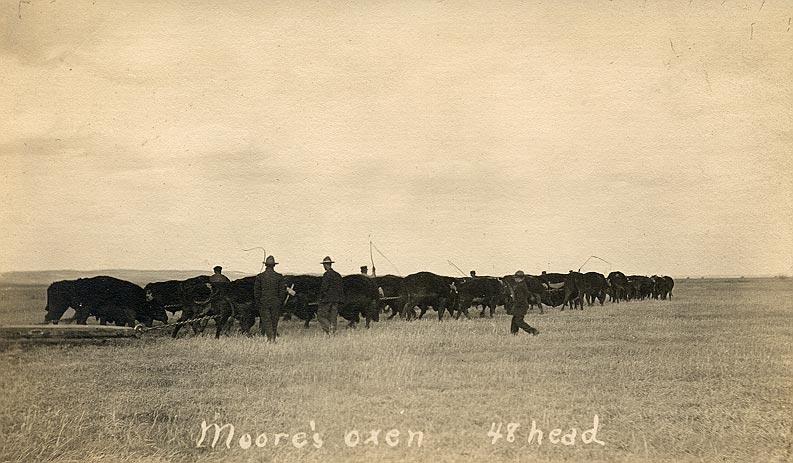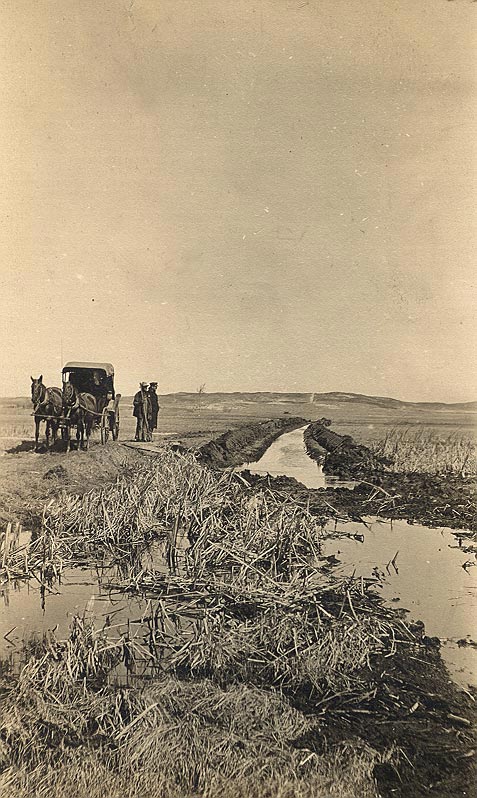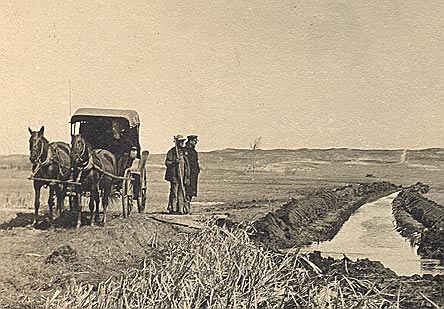Historic Photographs
Digging the Bull Ditch
The Moore Brothers of Missouri
The Bull Ditch was constructed by a cooperative to stop the town of Maxwell from flooding.

These
oxen were used to make a ditch to drain the swamp area west of town - the ditch
now called 'Bull Ditch.'
The 48 oxen teams pulled huge lister plows through
the swamp.
The owner and driver was a man named Moore - not a local man.
In one place the plow sank and had to be dug out.
(This information was written
on the back of the photograph
by my Grandmother, Inez Huntington, who was
there.)

Six
to eight man would ground drive and manage three or four teams spread along the
lines.
The Moore Brothers of Missouri traveled the west with their lister plows
and bull oxen.
Many of them were wild Sandhills bulls straight off the range.
Sandhill bulls off the range were not at all happy to be yoked to work.
Some
of the bulls were quite tame while others were quite dangerous.
They would
yoke the wild ones to a big, experienced tame one.
Leaving them yoked together
for days at a time to tame them.

When
a team bogged down in the swamp the other teams would pull them out.
They often
needed to replace the bulls as the continuous immersion in the swamp was hard
on the feet.


The
Bull Ditch was built to divert the swampy area west of Maxwell where it would
flood the town
and surrounding areas when rain and the spring thaws would
flood the town,
keeping the water west of Maxwell, sending the water straight
south, down the Bull Ditch
to the Platte River without going through the town
of Maxwell. We need this Bull Ditch restored!

Another
purpose of the Bull Ditch was to permit people to get to North Platte to shop
rather than the only other route to North Platte by way of State Farm Rd.
at the edge of the hills several miles south of Maxwell.
This was long
before highway 30. It also made it possible to make highway 30.
The
Bull Ditch starts north of Highway 30 west of town where natural springs,
rain
and spring thaws bring down water from the Sandhills. It should then run straight
south
into the Platte River, bypassing the village, not running through the
village as the article states.


The Bull Ditch Lister Plow
This plow was used to dig drainage ditches along the Platte River Valley to drain flooded farm land and villages.
During the drought of the late 1880s irrigation ditches were dug to use water from the river. This soon created problems when low lands flooded. Seepage from the irrigation ditches turned the land into swamps. Farmers decided to try to dig drainage ditches through these low land lakes and swamps and put the water back in the river. The Moore Brothers Company dug ditches with a huge lister plow pulled by oxen. The "bull plow" was much quicker than men with shovels and much better adapted to swampy areas than horse drawn equipment or the primitive power machinery available. Around 1908 the Moore Brothers huge plow and some of the 48 oxen needed to pull it arrived on the Union Pacific. About 15 extra Oxen were also kept on hand as well. They purchased and trained more oxen, most of them were wild Sandhill bulls, newly castrated, that often did not take kindly to their new status as work animals.
Twenty four yoke of oxen were chained together from yoke to yoke and finally to the plow. Six to eight men each controlled three or four teams spread out along the line and as the 38 tons of oxen muscle leaned against the yokes, a ditch began to curl away from the plow. In a good day the huge train of oxen teams could dig as much as a half a mile of ditch measuring about seven feet across the top and three feet at the bottom.
When a team bogged down in the swamp the other teams dragged it loose. If a team refused to pull, the rest dragged it along until the pair gave up and joined the force.
This plow worked it's way from Big Springs, NE to eastern Wyo. and down River through Brule, NE and Ogallala, NE and then on to the North Platte, NE area including Maxwell, NE.
Nebraska's most familiar problem - Water - either too little or too much. In the late 1800s and early 1900s, as open range was plowed into farmland water problems were familiar. The slogan of the early promoters was, "Irrigate or Emigrate."


The crab (Anchor) was used with a pulley system that was hooked to the ditch plow and the oxen. It created a 2 to 1 or a 3 to 1 mechanical advantage, depending on how the two pulleys were rigged, making the ditch move one-foot for every 2 or 3 feet the oxen moved. These ditches were referred to as "Bull Ditches" because of the Bull Oxen used.
If the water became too deep, a capstan was set up and the oxen were hooked to the bar and the lister plow was winched along until it reached shallows again.

The
Bull Ditch lister plow, capstan, and the crab used to dig the Maxwell Bull Ditch
is on display at the Lincoln County Museum in North Platte.
| History with its flickering lamp stumbles along the trail of the past, trying to reconstruct its themes, to revive its echoes and kindle with pale gleams the passion of former days. -Sir Winston Spencer Churchill- |
Old
Time Photographs & History of the Village of Maxwell, Nebraska |
View
Photo of Our Historic Loggy from Fort McPherson |

Click
Here To See More
Old Time Photographs & History of Maxwell, Nebraska

| Email
me Here | ||

All photographs on this site should be considered copyrighted to their original
artists.
This site was created in 1999-2008 by A. Olsen ęCopyright 1999-2008,
A. Olsen. All Rights Reserved.
